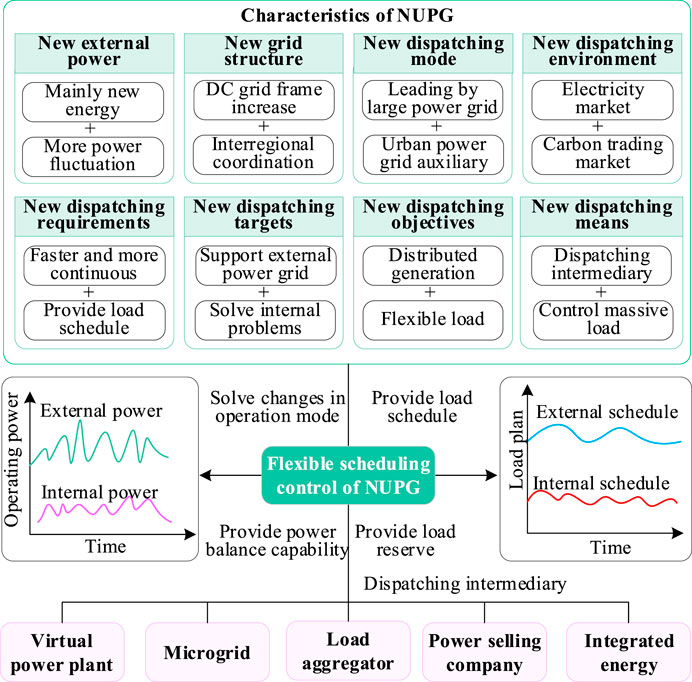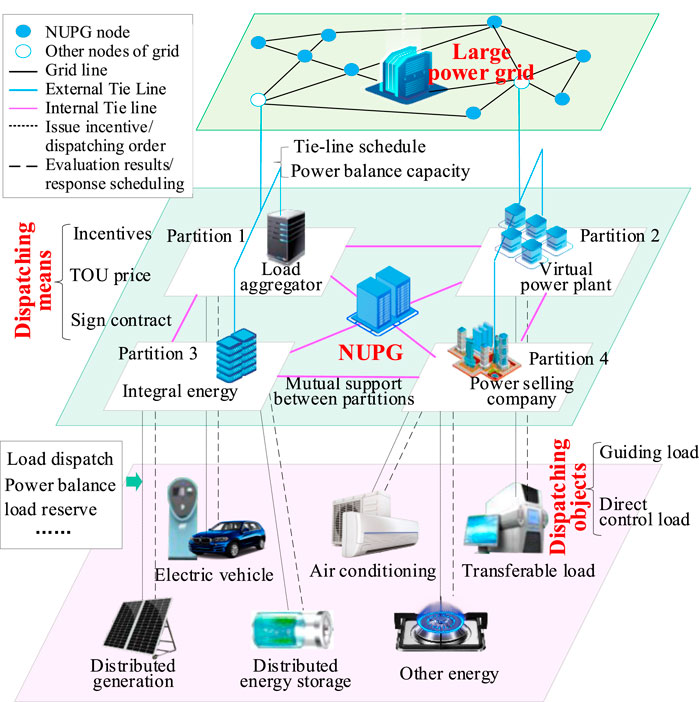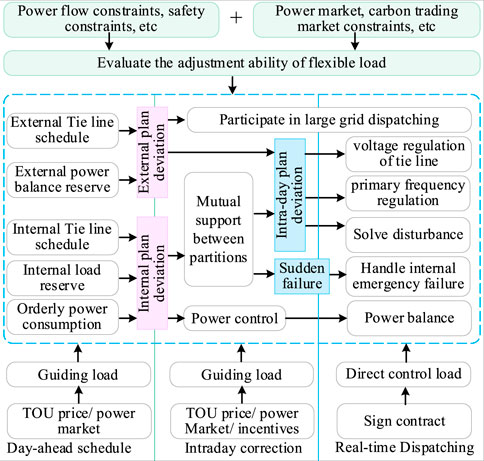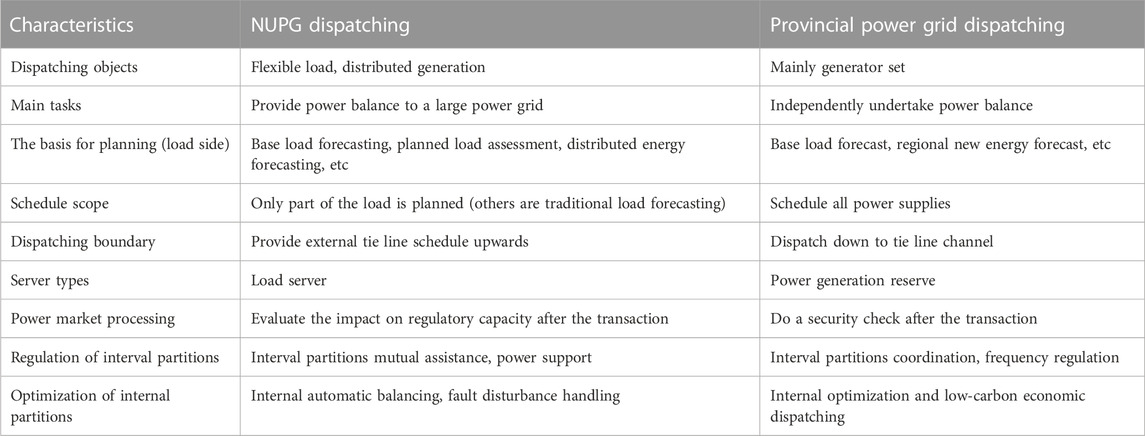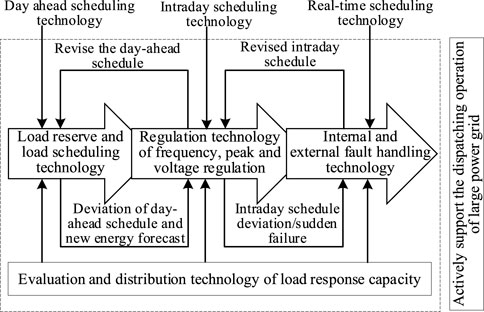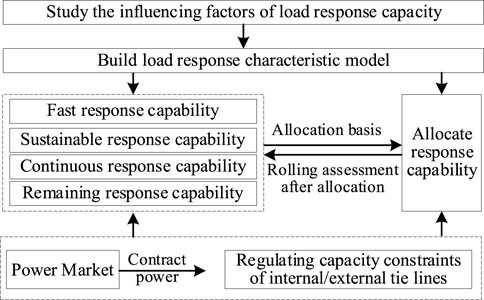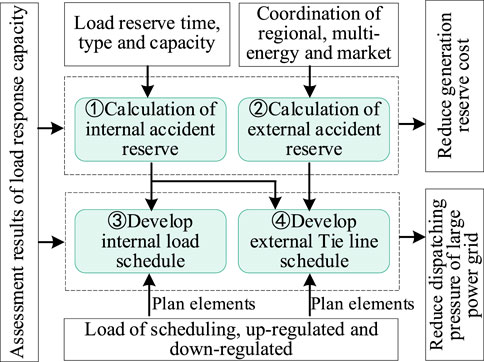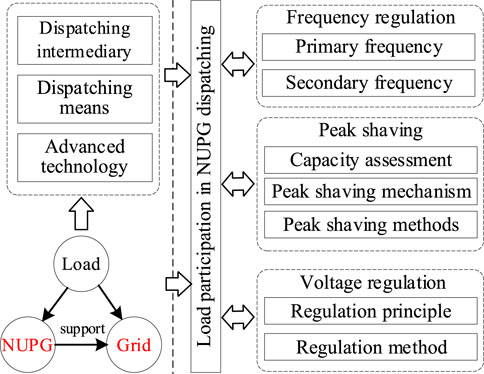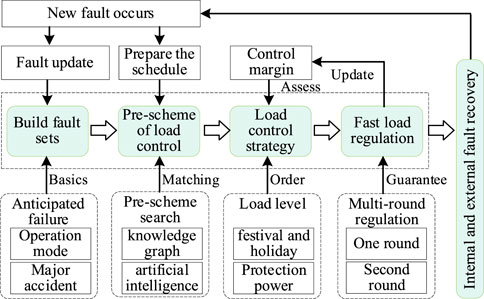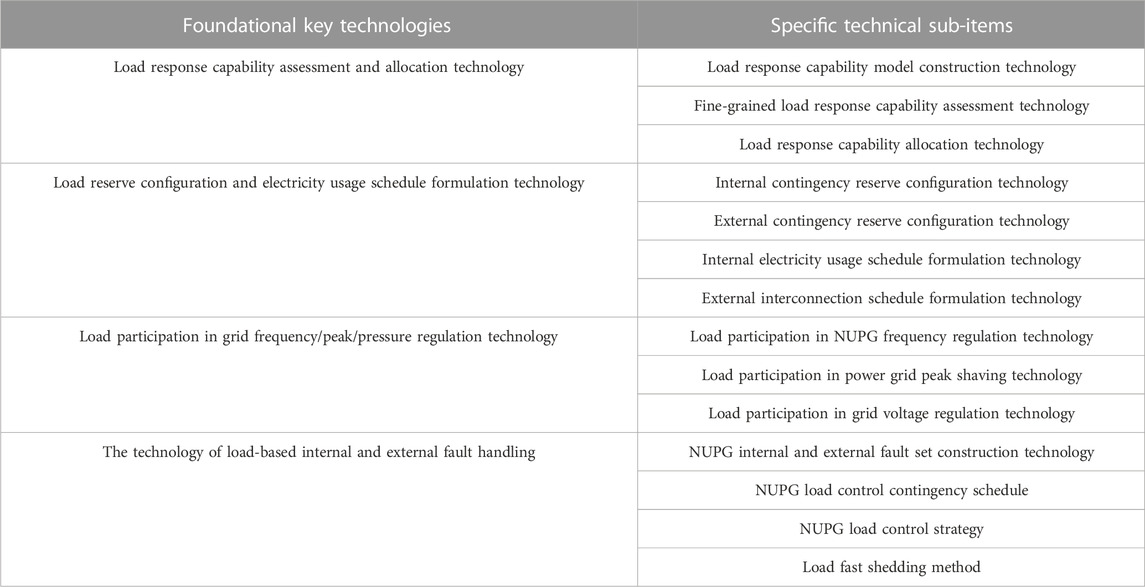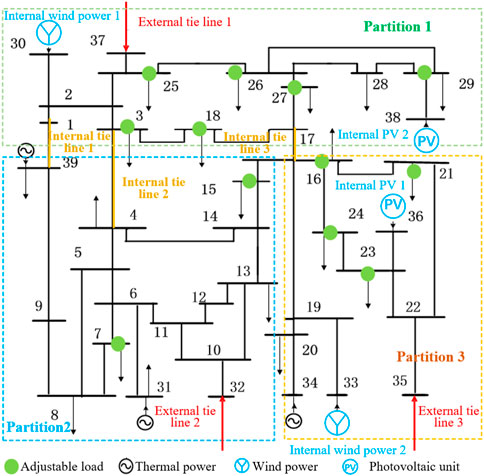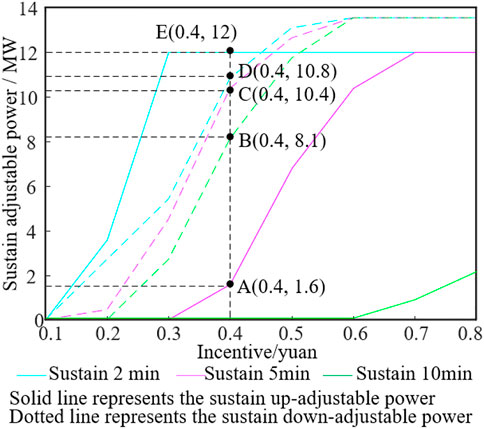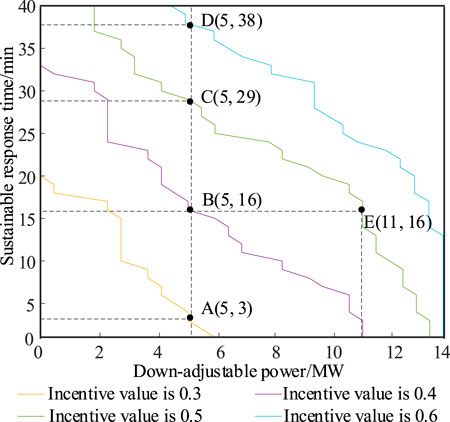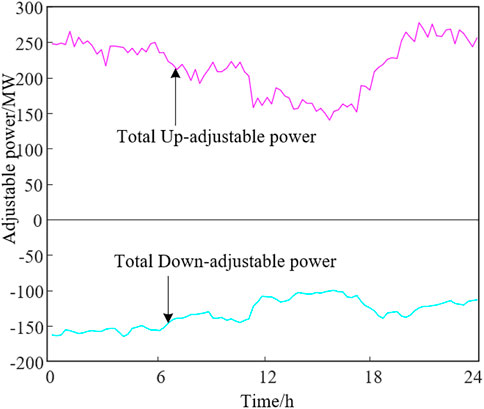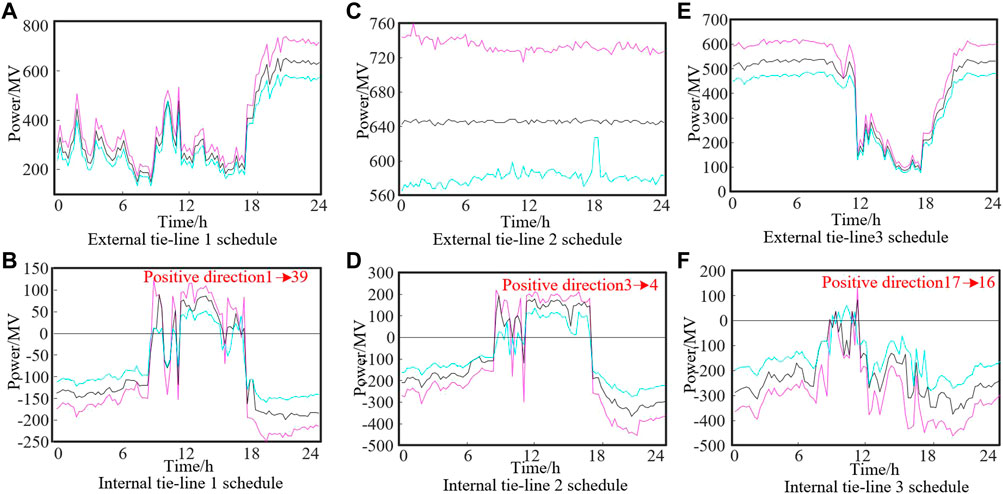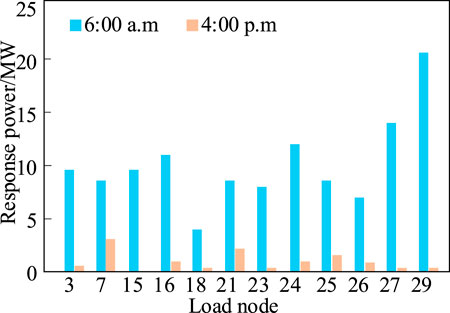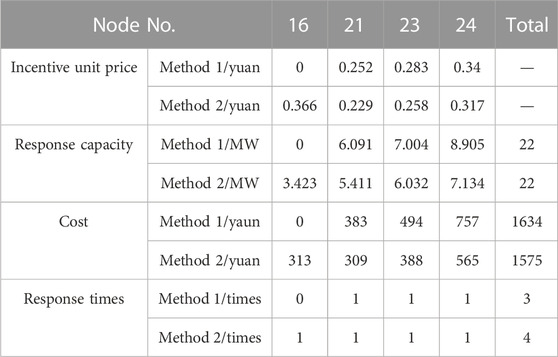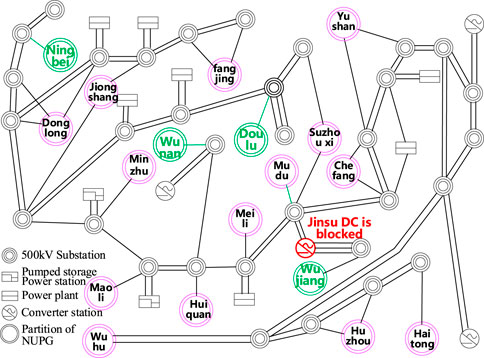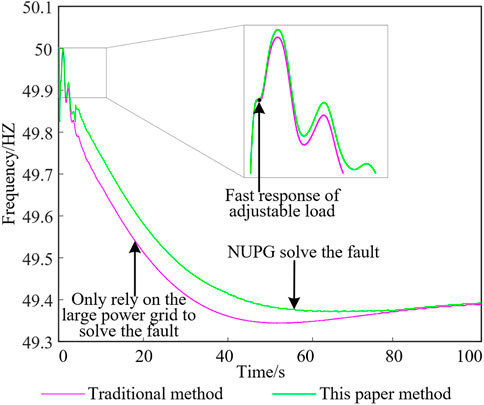- School of Electrical Engineering and Automation, Harbin Institute of Technology, Harbin, China
Towards the dual-carbon goals, the new urban power grid (NUPG) dominated by new energy has a low proportion of adjustable power generation units, resulting in insufficient scheduling flexibility. As a result, it becomes challenging to cope with the complex operating conditions of the NUPG. In this paper, after analyzing the new operational characteristics and challenges of the NUPG, a flexible load dispatching architecture and key technologies for the NUPG are proposed. These enhance the scheduling flexibility of the NUPG from the load side, which further provides support for the operation of the large power grid. Then, the types of scheduling objects, scheduling methods, scheduling tasks, and four essential dispatching technologies are introduced to provide a reference for building the NUPG flexible load dispatching system. Finally, the effectiveness of the NUPG flexible dispatching architecture and technologies is verified by simulation analysis of the IEEE39-bus system and the actual power grid in East China.
1 Introduction
Under the “3060”dual-carbon target, the future power system will be dominated by new energy (Han et al., 2021; Liu et al., 2022). The power supply of the urban power grid comes from the external power system (Sun et al., 2021; Yu et al., 2021). Therefore, the urban power grid will transform into a new urban power grid (NUPG) dominated by new energy. Due to the insufficient proportion of traditional adjustable hydro and thermal power units. NUPG will face the challenges of the changeable operation mode of the external new power system, the internal operation conflict between the source grid load storage, and the severe conflict of the internal and external operation mode to NUPG operation (Zhao et al., 2022). Therefore, it is urgent to improve the flexibility from the load side and respond to the internal and external operation requirements of NUPG. The new urban power grid is a new type of urban power system that primarily uses renewable energy for power supply, takes the load as the main dispatching object, and actively shares the dispatching tasks of the main grid.
The load-side of NUPG has many flexible resources: 1) The adjustable load has increased significantly. It is estimated that the number of electric vehicles in China’s cities will exceed 50% of the total vehicles by 2050 (Zhengyou et al., 2020). The installed capacity of energy storage will exceed 200 GW (Liu et al., 2017). The proportion of air conditioning load in some cities in summer has exceeded 50% (Zhang, 2022). 2) The proportion of distributed new energy increased. At present, the installed proportion of distributed new energy in the total power generation capacity of the grid is more than 20%, which is expected to exceed 50% by 2050 (Energy Research Institute of National Development and Reform Commission, 2015), and the distributed new energy in the urban grid will also gradually increase (Bie et al., 2022). 3) Flexible DC has the regulation characteristics of good flexibility and fast regulation speed. Its application in the urban power grid has gradually increased in recent years, which can improve the flexibility of NUPG internal power regulation (Li et al., 2022). 4) In the future, NUPG will include a variety of flexible energy sources, such as steam, heat and hydrogen (Schulthoff et al., 2021), to jointly support NUPG operation.
Currently, the urban power grid is uniformly dispatched by the provincial large power grid and operates passively as a role of load. Reference (Yuan and Tang, 2021) evaluates the demand response capability of electric vehicles and utilizes them to reduce the voltage impact on the distribution network by constructing a road-electricity coupled network model. Reference (Wang et al., 2018) evaluates the ability of air conditioning load to participate in demand response. Reference (Kai et al., 2018) utilizes air conditioning load to participate in grid frequency regulation services. Reference (Wu et al., 2020) proposes combining electric vehicles and HVAC systems to increase flexibility and participate in ancillary services. Reference (Liu et al., 2019) utilizes a house energy management system to participate in peak shaving services for the power grid. Reference (Yang et al., 2015) proposed a specific implementation method for public buildings to participate in peak shaving services, dividing building management into building-level, terminal-level, communication-level, and primary station levels and managing it from bottom to top. Reference (Li W. et al., 2021) proposes an optimal incentive strategy for demand response participation based on electricity usage preferences of shiftable loads.
In summary, existing methods for addressing power grid operation issues still primarily focus on dispatching thermal and hydroelectric power, while load participation plays a supplementary role, and both the scale and capacity of dispatched loads remain relatively small. Moreover, in existing methods, load lacks unified control and management (Cai and Luo, 2023), and its flexibility has not yet been fully exploited (Yang C. et al., 2022). Therefore, in scenarios where the proportion of dispatchable thermal and hydroelectric power in the NUPG is insufficient, existing load control methods struggle to provide enough capacity to meet the operational needs of the NUPG. There is a need to study new dispatching models to schedule all adjustable loads within the NUPG, satisfying the operational demands of the power grid.
In this article, we propose NUPG’s flexible load scheduling architecture and key technologies. The contribution of the proposed method is summarized as follows.
1) A flexible scheduling architecture for NUPG is constructed. This architecture enables NUPG to actively undertake scheduling tasks from the new power system, serving as a new large-scale dispatchable entity rather than passively operating as a traditional load role.
2) The main fundamental key technologies for NUPG’s flexible scheduling are provided. Instead of making hydro and thermal power units the main scheduling object, and rather than small-scale participants as ancillary services, this technology makes load resources the main scheduling object.
3) The flexible load scheduling architecture and key technologies proposed in this paper mainly target the future dual-carbon goals, providing references for solving the bottleneck problems in the “3060”roadmap and future urban power grid operation modes.
The rest of this article is organized as follows: The characteristics and challenges of NUPG are described in Section 2. The NUPG flexible scheduling architecture is analyzed in Section 3. Section 4 introduced the key technologies of NUPG flexible scheduling. The simulation results are presented in Section 5. The article is concluded in Section 6.
2 Characteristics and challenges of NUPG
NUPG has eight main characteristics under the “3060”dual-carbon target, as shown in Figure 1.
1) New external power. The injection power of traditional urban power grid is mainly thermal power, which is relatively stable and less fluctuate. In the future, NUPG injection power will be dominated by new energy, and the fluctuation and uncertainty of injection power will increase significantly.
2) New grid structure. The traditional urban power grid is based on AC and a double-loop structure, and the coordination between partitions is not flexible enough. When some partitions have faults or power shortages, it is difficult for other partitions to support power in time. Flexible DC technology (Gomis-Bellmunt et al., 2019) will increase the power coordination capability of each partition in NUPG.
3) New dispatching mode. The dual-carbon target has impacted all links of power grid dispatching, increasing the difficulty of dispatching and requiring more subjects to participate. The new power system dispatching mode will change to coordination between large grid dispatching and NUPG dispatching. NUPG undertakes the task of large grid dispatching and reduces the pressure of large grids.
4) New dispatching environment. Under the dual-carbon goal, on the one hand, the power grid will conduct low-carbon dispatching to reduce carbon emissions. The cost of carbon emissions will distribute to users through the carbon trading market. On the other hand, the contracted electricity purchased by users through the electricity market needs to be transmitted through the internal tie line, which affects the capacity and regulation capacity of the tie line.
5) New dispatching requirements. NUPG injection power has more substantial fluctuation and a shorter period, which puts forward higher requirements for NUPG regulation: NUPG needs a shorter period and sustainable regulation ability to support real-time power balance.
6) New dispatching targets. On the one hand, NUPG needs to undertake the scheduling task of the external power grid. On the other hand, it is necessary to balance the fluctuating power injected by the external power grid to ensure operational stability. In addition, it is also essential to meet the power generation and consumption schedules of internal virtual power plants, microgrids, and load aggregators, as well as the tie-line plans between different power grids and the intra-day correction plans.
7) New dispatching objectives. The traditional power grid dispatching object is mainly hydro and thermal power units, and the load is passive. The Jiangsu power-grid-load system only involves a small-large load, and the control cost is high. The NUPG dispatching objects are mainly loads and distributed power sources, such as massive electric vehicles, controllable air conditioners, and transferable loads.
8) New dispatching means. It is difficult for NUPG to directly control each air conditioner and each electric vehicle due to the control cost constraints and the impact of the control effect. It needs new control means as a medium, such as load aggregators, to control the massive controllable load.
Based on the above characteristics, NUPG operation will face the challenges of changing the external new power system operation mode, internal operation impact of source and load, and operation mode conflict between internal and external.
1) The challenge of changing the operation mode of an external new power system. The absolute value of power fluctuations will be immense based on the proportion of existing power fluctuations in new energy. It is challenging to balance power and electricity. The uncertainty of new energy power will bring about variable operation modes and challenge scheduling flexibility.
2) The challenge of internal operation conflict between source gird load. The first challenge is the role change of NUPG from passive load to active participation in scheduling. The second challenge is the conflict between internal massive distributed power generation, flexible load disorder operation and power grid stability. The third challenge is the expansion of scheduling objects, the application of new technologies, the introduction of the carbon trading market and the impact of new business development in the future.
3) The challenge of internal and external operation conflicts. The frequent change of operation mode is a challenge to adapt to the change of self-sufficiency, the change of external dependence, and the intertwined factors such as unplanned operation mode, power fluctuation, and internal and external faults. Unexpected operation mode challenges brought by uncertainties.
3 NUPG flexible load scheduling architecture
For the challenges faced by NUPG, under the existing unified scheduling and hierarchical management mode, this paper proposes a flexible load scheduling architecture for NUPG. This architecture can improve the flexibility of NUPG and support the internal and external operation of NUPG, as shown in Figure 2.
This architecture takes load aggregators, virtual power plants, integrated energy companies, and power retailers as dispatching entities, integrating massive controllable load resources through incentives, electricity prices, contracts, and other means. This feature endows NUPG with dual power supply and load attributes, enabling bi-directional power regulation. The dispatch entities in each partition may differ but have similar functions, all capable of increasing or decreasing power (Similar to the function of several large urban virtual pumped storage power stations). Internal tie lines enable mutual power support between different partitions. When a partition experiences a failure, other partitions can provide powerful support. This architecture serves the higher-level power grid dispatch, with the load as the main scheduling object (instead of the traditional power grid where hydro and thermal power units as the main scheduling object), proactively sharing the burden of power grid regulation tasks. It also serves the lower-level internal power grid operations, addressing internal issues within NUPG. We will introduce the architecture from three aspects: scheduling objects, scheduling means and scheduling tasks.
3.1 Scheduling object of NUPG
The load of NUPG consists of a basic load and an adjustable load. 1) The basic load mainly refers to the uncontrollable load that meets the basic living and production needs. When making the day-ahead load schedule, this part of the load is predicted by the conventional urban power grid load forecasting method (Xiao et al., 2021). 2) The term “adjustable load” refers to flexible resources that can be adjusted to meet production and daily needs, such as air conditioning loads that can be changed within the comfort interval (Fu et al., 2022), electric vehicle loads that can be charged and discharged flexibly without affecting the operational schedule (Yu et al., 2022), and transferable loads that can be independently selected during power consumption intervals (Yang et al., 2020). Distributed power generation is a kind of crucial flexible resource, mainly including the whole county/region photovoltaic (Qiu, 2022), distributed energy storage (Cai Z. et al., 2022), and distributed new energy around the city (Wang et al., 2023).
The adjustable load can be divided into guided and direct control loads according to the dispatching means. 1) Guided load refers to the flexible resources that participate in regulation through electricity price (Cai Q. et al., 2022), electricity market (Wang et al., 2021) and incentives (Wang et al., 2022). The response time scale varies from minute level to hour level. 2) Directly controlled load mainly refers to the load that is directly controlled by signing a contract with some high-quality users with a large adjustable capacity and fast response speed, as well as the distributed power supply that can be directly controlled. The response time scale is seconds and can be directly controlled in an emergency (Hu et al., 2022).
With the development of technology, high energy consumption loads such as electric heating, electric molten magnesium, electrolytic aluminum, and gas and heat energy can participate in NUPG dispatching in the future.
3.2 Scheduling means of NUPG
On the one hand, the flexibility resources of NUPG are various, large in quantity, widely distributed, small in single regulation capacity, high indirect regulation communication cost, and limited in the computing resources of the control centre, which makes it difficult for NUPG to schedule a single load directly. On the other hand, most flexible resources have dual attributes of production and consumption, and the controllability is lower than that of the traditional generation units. Therefore, need new means to ensure the effectiveness of NUPG scheduling.
In this paper, load aggregators are used to controlling many flexible resources, and different means are selected according to different dispatching needs. For day-ahead dispatching, users can be guided through electricity prices to formulate day-ahead power use plans. For intra-day dispatching, users can be guided to participate in intra-day dispatching through electricity price or incentive means. For online scheduling, flexible resources can be controlled directly in an emergency by signing a contract with users.
Electricity price is one of the crucial means of NUPG dispatching. It controls power indirectly by influencing the power demand of users, mainly including time-of-use and real-time electricity prices. The time-of-use electricity price can be used for peak shaving and valley filling, and the real-time electricity price can be used for secondary power control. Secondary power control relates to peak shaving and valley filling, and peak shaving and valley filling can help reduce the pressure of secondary power control.
3.3 Multi-time scale scheduling task of NUPG
Under the constraints of power flow constraints, security constraints and the electricity market, the main dispatching tasks of NUPG are shown in Figure 3.
3.3.1 Make a day ahead scheduling task
Based on the results of the pre-day adjustment capability assessment of the load within the NUPG, and considering the impact of contract electricity on the capacity of internal tie lines, an internal tie line schedule is developed. This schedule reserves dispatching capacity for power support between different regions. Prepare an internal accident backup schedule to deal with internal accidents. Formulate an internal orderly power utilization schedule to deal with the internal power balance problem of NUPG in case of power shortage. An external tie-line schedule is established to provide some regulatory leeway for balancing fluctuations in renewable energy power in the larger grid, thereby reducing operational pressure on the larger grid. Develop an external power balance reserve schedule to support a large power grid’s power balance or failure.
3.3.2 Rolling correction of intra-day scheduled tasks
The load shall be adjusted to revise the day-ahead power consumption schedule according to the deviation from NUPG’s internal and external operation schedule. Because of the power balance deviation of the large power grid, the internal guiding load shall be mobilized to participate in the daily continuous peak shaving and continuous peak shaving tasks of the large power grid through electricity price or incentive means. Because of the internal power balance deviation, the guiding load shall be mobilized to participate in the secondary power control to achieve the power balance in the area through electricity price or incentive. Dispatch a load of the different regions through the internal tie line in the area, realize mutual power support in other locations, and improve the internal disturbance and fault handling capability.
3.3.3 Online real-time scheduling tasks
For intra-day schedule deviation or sudden failure, direct control load shall be mobilized to participate in the power grid’s rapid peak shaving, primary frequency regulation, or internal emergency fault handling tasks to achieve power balance. In response to the voltage stability margin insufficiency problem caused by inadequate renewable energy supply capacity, which in turn results in insufficient reactive power support problem, load shedding is primarily used to maintain supply-demand balance and thus ensure voltage stability. Depending on different circumstances, either direct load control can be chosen, or electricity pricing/incentives can be used to mobilize and guide the load in addressing voltage stability problems.
3.3.4 Market mechanism
When NUPG arranges the dispatching schedule, it should prioritize meeting the schedule of the market part (such as the power purchase contract) and meeting the requirements of the grid security check. The corresponding market mechanism is needed to guide the load to participate in the response within the load aggregator. In addition, the related carbon trading mechanism is required because of the future low-carbon scheduling objectives, and the impact of carbon constraints is considered in the scheduling.
3.3.5 Difference between the provincial power grid and NUPG dispatching
NUPG and provincial large power grid dispatching work in close cooperation and division of labour, each undertaking part of the dispatching tasks. The specific characteristics are shown in Table 1.
4 Key technologies of NUPG flexible scheduling
Because of the new changes in the NUPG dispatching objects, tasks and objectives, the original dispatching mode with the participation of the primary power source and the small-scale participation of the load is difficult to adapt to the operational requirements of the new power system. With the reduction of the adjustable capacity of the power supply side, the load will become the main dispatching object (Hu et al., 2022). Therefore, the station re-examines the load-dispatching technology under the NUPG control objectives and tasks. In the future, there will be many key technologies for load-based participation in NUPG scheduling. With the development of new technologies such as big data and artificial intelligence, the technologies will continue to be updated. Due to the space limitations of this paper, we mainly discuss fundamental key scheduling technologies within the time scale of day-ahead, intra-day, and real-time scheduling for the primary grid. The fundamental dispatching key technologies involved mainly include load response capability assessment and distribution technology, load server configuration and load schedule formulation technology, load participation in frequency regulation/peak shaving/voltage regulation technology, and load-based internal and external fault handling technology. The above key technologies constitute the NUPG flexible dispatching technical architecture, as shown in Figure 4.
4.1 Load response capacity assessment and distribution technology
In the new power system, the requirements for response capacity and response duration are different at different times and spaces. Therefore, to better support the operation of the new power system, it is necessary to evaluate the load response capability of NUPG with multiple time scales and dynamic updates. Furthermore, the evaluation and distribution technology of load response capability for NUPG dispatching is proposed. This technology aggregates massive loads through load aggregators to evaluate the responsiveness of NUPG, as shown in Figure 5.
It mainly includes three key technical issues: 1) Load response capability model construction technology. It fully considers the impact factors of different types of load response capability (economic, operational, environmental, and other factors), effectively reflecting the response characteristics of different loads and alleviating the uncertainty of load response. 2) Assessment technology for the response capability of different time scales supporting the large power grid. It mainly includes assessing rapid response capability online or emergency dispatching scenarios, sustainable response capability under fault disposal scenarios (The duration for which a certain power can sustain its response, such as how long 10 MW can be maintained sustainably), continuous response capability under continuous power fluctuation scenarios (The ability to continuously respond under continuous dispatch instructions), and residual capacity after response. 3) Responsiveness allocation technology. According to the scheduling requirements of different regions or scenarios, the response capability is allocated based on the user response characteristics, scheduling media revenue and the capacity constraints of tie line adjustment. After the allocation, the response capability is evaluated in a rolling manner.
Taking EBL (Electric Bus Load, EBL) as an example, the response ability assessment technique is introduced (Zhang and Yu, 2022). The online response ability assessment model of EBL is shown in Eq. 1.
Where
4.1.1 Power increase capability of Electric bus load
The EB can increase its power in charging mode as shown in Eq. 2. As for the EB in the discharging state, the response process is as follows: Discharging—>Stopping discharge—>Charging: the first step uprated capacity is
The constraint conditions are:
4.1.2 The power reduction capability of the Electric bus load
The EB can reduce its power output in charging mode as shown in Eq. 4. As for the EB in the charging state, the response process is as follows: Charging—>Stopping charging—> Discharging. The first step has a power reduction capability of
The constraint conditions are:
The assessment of the up and down adjustment capability of the EB in battery swapping mode is similar to that in charging mode, but due to space constraints, which will not be described here.
4.2 Load reserve configuration and load scheduling technology
The load side resources of NUPG are various, large in scale, complex in the system and increase in business: on the one hand, it needs to expand the internal business to solve internal problems. On the other hand, it needs to undertake part of the task of a large power grid. Therefore, load scheduling is necessary to reduce uncertainty. This paper proposes the technology of load reserve configuration and power schedule formulation for NUPG dispatching. After reserving a certain proportion of NUPG internal load reserve, it provides load reserve for large power grids and reduces the cost of power generation reserve. In addition, the technology actively provides a NUPG load schedule to the large power grid to reduce the pressure on the large power grid, as shown in Figure 6.
The key technologies are as follows: 1) Internal emergency reserve configuration technology, mainly including the configuration technology of emergency reserve at different time scales; Emergency reserve configuration technology of different reserve types and reserve capacity optimization technology. 2) External emergency standby configuration technology. In addition to considering the reserved time, style, and capacity. It is necessary to study the emergency reserve mutual aid technology between NUPGs and different forms of emergency reserve coordination technology. 3) Internal load scheduling technology. Considering the evaluation results of response capability and accident reserve, the schedule of the NUPG internal liaison line is given to support internally coordinated operations. Formulate an orderly electricity use schedule to deal with the problem of how to balance the electricity in case of power shortage in a special period (long time, large range of no wind, no light). 4) External tie-line scheduling technology. Considering the internal and external emergency server configuration, the NUPG external tie-line schedule is formulated for the large power grid to reduce the dispatching pressure of the large power grid.
Taking the technology of formulating schedules based on load-based external tie lines as an example. Firstly, the load regulation margin model of NUPG partition k is constructed based on Eq. 1, as shown in Eqs. 6, (7).
Where
Based on the load regulation margin model of NUPG partition, the adjustable margin model of external tie lines of NUPG is constructed as shown in Eq. 9.
Where
According to Eq. 9, the power grid can establish the electricity schedule
Unlike the traditional approach of strictly adhering to load forecasting curves for creating electricity consumption schedules, our proposed method allows the grid to create a schedule within the adjustable capacity range of the external tie lines, which provides a more relaxed operational constraint for the power grid and reducing the pressure on its operation.
4.3 Load participation in frequency modulation/peak shaving/voltage regulation technology
In the new power system, the regulation capacity of the power supply side, such as the traditional hydro-thermal unit, is insufficient, so the load is required to participate in the power grid regulation. However, the load in the existing technology is only small-scale participation in grid operation (Zhang Y. J. et al., 2022), which is difficult to adapt to the demand of NUPG large-scale load participation in grid dispatching.
In addition, the load is the dual identity of production and marketing, which requires new technology to control effectively. Therefore, it is necessary to study the power grid frequency regulation/peak regulation/voltage regulation technology for load participation in NUPG regulation objectives and tasks to meet the dispatching requirements of the new power system, as shown in Figure 7.
Specific key technologies include.
1) The load participates in NUPG frequency modulation technology. It mainly includes the load participating in the large power grid’s primary frequency regulation mechanism, the NUPG secondary frequency regulation method to respond to the primary frequency regulation demand of the main external network, and the internal uncertainty disturbance. 2) The load participates in the peak-shaving technology of a large power grid. It mainly includes the capacity assessment of load participating in peak shaving, peak shaving mechanism and peak shaving method, etc., to fully mobilize load resources and respond to multi-timescale peak shaving demand. 3) Load participates in voltage regulation technology of large power grids. To solve the voltage stability problem, it is necessary to study the principle of load participating in the voltage regulation of a large power grid, establish the NUPG load voltage regulation mechanism, and study the method of load participating in the voltage regulation of a large power grid. In this way, NUPG can improve the large power grid’s voltage security and stability level.
Take the sustainable peak-regulating capacity evaluation model under the peak-regulating command as an example. Set the peak-regulating command
When
Where
4.4 Internal and external fault handling technology based on load
Because of the insufficient regulating capacity of the power supply unit of the new power system, it is necessary to dispatch the NUPG load to deal with the faults (Yang Q. M. et al., 2022). Facing the MUPG control objectives and tasks, it is necessary to study the internal and external fault handling technology based on load resources, develop the system’s load control schedule, handle the internal faults of NUPG, and actively support the large grid faults (Chen et al., 2023), as shown in Figure 8.
Four key technologies are mainly studied: 1) NUPG internal and external fault set construction technology. It includes the construction technology of the expected fault set considering the changeable internal and external operation modes and major accidents, and the updated technology of the fault set for new faults. 2) NUPG load control schedule. It mainly includes the formulation of a load control schedule for a fault set, the formulation of an interval coordination schedule, and the search technology of a load control schedule based on a knowledge map or artificial intelligence. 3) NUPG load control strategy. It includes the classification of load levels, determination of control order and dynamic evaluation of control margin considering holidays and electricity conservation information. 4) Fast load removal method. It includes the first round fast cutting method of contract load and the second round cutting method of guiding load. After cutting off the load, the load control margin is updated.
We take the optimal control strategy for handling internal faults as an example. A load optimal control strategy considers user experience and economic efficiency, mobilizing the loads within the partition for fault handling, as shown in Eq. 14 The model aims to minimize the number of users involved, achieving cost-effective handling of internal faults.
Where
In summary, the following is a list of the fundamental new key technologies involved in this article as shown in Table 2.
5 Case studies
This section uses the IEEE-39 system and the actual system in East China to analyze some of the above key technologies (response capability assessment, load reserve and power utilization schedule formulation, and NUPG internal and external fault handling).
As shown in Figure 9, nodes 32, 35, and 37 are the connection points of external tie-line 1, 2, and 3, which are the actual wind farm data of East China Power Grid: SS wind farm, BY wind farm and SG wind farm. Nodes 30 and 33 are connected to the wind farm. Nodes 36 and 38 are connected to the photovoltaic power station. The green dot mark in the figure shows the adjustable load.
5.1 Refined assessment of load response capability
There are 8 lines connected to the electric bus station at node 7, 4 lines are in charge mode, 4 lines are in charge mode. The battery capacity of the charging line EB (electric bus, EB) is 220 kW⋅h, the battery capacity of the exchange line EB is 200 kW⋅h and the maximum charging and discharging power of the two types of single EB is 120 kW.
5.1.1 Load fast response ability with multiple time scales
Based on the response evaluation technology, the EB of node 7 is stimulated differently at 6:00 to evaluate its rapid response capability within 2, 5, and 10 min. The results are shown in Figure 10.
As shown in Figure 10, the same node has different rapid response capabilities under different demand durations. For example, when the incentive is 0.4-yuan, node 7 can rapidly increase the power by 12 MW in 2 min, while only 1.6 MW in 5 min. This is because some EBL (electric bus load, EBL) have finished charging at 6:00, and the remaining charging space is limited, so it can only participate in the power increase for a short time. The scheduling period of traditional methods is primarily 15 min (Cui et al., 2021). Traditional approaches fail to provide the load’s quick response capacity at different time scales.
5.1.2 Assessment of loads’ sustainable peak load shifting ability at multiple time scales
Based on the sustainable peak shaving capability evaluation model, the sustainable peak shaving capability of node 7 is evaluated under different incentive values, and the results are shown in Figure 11.
Figure 11 shows varying sustainable peak-shaving durations at the same node under different response powers. For instance, with an incentive value of 0.5 yuan, the maximum sustainable peak-shaving duration is 16 min at 11 MW power response and 29 min at 5 MW power response. At an incentive value of 0.4 yuan, the maximum sustainable peak-shaving duration is 16 min when responding to 5 MW power response. The traditional approach has a scheduling cycle of 15 min (Zhang H. et al., 2022), and can not provide sustainable load response capability at different time scales. The high proportion of power fluctuating in NUPG needs sustainable peak-shaving, but the traditional approach (Zhang H. et al., 2022) can not support this scene.
5.2 Load server configuration and load scheduling
According to the load response capability evaluation technology, the response capability of adjustable points in each partition is evaluated. The total amount of NUPG adjustable power up/down is obtained, as shown in Figure 12. Among them, partition 1 is connected with a controllable air conditioning load, partition 2 is connected with an electric vehicle load, and partition 3 is connected with the transferable load.
According to the adjustable load capacity, the NUPG internal and external tie lines schedule is calculated based on the load standby configuration and power scheduling technology, as shown in Figure 13.
According to Figure 13, the external tie line schedule mainly provides adjustable power upper and lower limits from NUPG to the large power grids. When formulating schedules, large power grids do not need to follow the traditional load forecasting curve strictly. Still, they can adjust within the upper and lower limits, which significantly loosens the constraints of large power grid operation schedules. The internal tie line schedule considers the impact of contract power on the regulating capacity of the inner interconnection line and supports inter-regional power support and fault handling.
5.3 Internal and external fault handling of NUPG
5.3.1 Internal fault handling of NUPG
5.3.1.1 Fault handling under different load spatial distributions
Faults were set at the external tie line at 6:00 a.m. and 16:00 respectively, and the power of the tie line was 220 MW. Calculate the power value of the actual response of each adjustable load, as shown in Figure 14.
Figure 14 shows that when the same fault occurs at different times, the actual response of the load is different. This is because at 6:00 a.m. and 4:00 p.m., the NUPG load has different spatial load distribution, and the adjustable amount of each load is also different, resulting in a different actual response. Take load node seven as an example. Node 7 is the aggregated load of the electric bus station. At 6:00 in the morning, most buses are charging, which can respond to power reduction. At 4:00 p.m., most buses are in a state of operation, and the online charging load is less, which can respond to the load.
5.3.1.2 partition-level fault handling considering the impact on users
At 3:00, a fault occurred within Partition 3, requiring the shedding load for 22 MW. Partition 3 has a load aggregator on nodes 16, 21, 23, and 24 respectively, each of them controlling 100 controllable users. Based on the optimal load control strategy for handling internal faults, load aggregators were invoked to deal with the fault, and the results are shown in Table 3.
In Table 3, method 1 represents this paper method, while method 2 represents the traditional method that does not consider the number of user response times (Li L. W. et al., 2021). When shedding the 22 MW load, method 1 incurred a cost of 1634 yuan with three response times, while method 2 incurred a cost of 1575 yuan with four response times. Compared to Method 2, Method 1 had a higher cost of 3.7% and reduced user response times by 25%, significantly minimizing the impact on user electricity consumption.
5.3.2 External fault handling of NUPG
East China Power Grid has four NUPGs, like Nanjing, Changzhou, Wuxi, and Suzhou. These four NUPGs support the operation of the East China Power Grid through transmission lines, namely, Ningbei, Wunan, Doulou, and Mudu, as shown in Figure 15.
Jinsu HVDC system experienced a blocking fault, resulting in a loss of 2600 MW of power. The fault was dealt with using both the method proposed in this article and traditional methods. The changes in the power grid frequency curve after fault handling are shown in Figure 16.
According to Figure 16, the NUPG load can respond quickly after a fault and improve the grid frequency. NUPG load participating in the grid fault handling is more conducive to the recovery of the grid frequency than relying on the main grid itself, which can effectively improve the stable operation level of the large grid.
The adjustable capacity and actual participation capacity of each tie line are shown in Table 4.
The effect of NUPG’s participation in the power grid fault handling is shown in Table 5.
In the method proposed in this article, the power increase amount of the power grid is 2020MW, which is 640 MW less than the traditional method (Wang et al., 2015), reducing the operating pressure of the power grid. The minimum frequency drop value of the power grid in this method is 49.4HZ, which is higher than the traditional method and is more conducive to the stable operation of the power grid. In addition, this method can effectively reduce the power grid reserve resources and save the backup cost of the power grid.
6 Conclusion
The impact of the low-carbon development of the external power grid and the diversification of internal load under the dual-carbon goal forces the transformation of the urban power grid to NUPG. This paper constructs a NUPG flexible dispatching architecture to share the dispatching pressure of a large power grid and improve the operational flexibility of NUPG.
1) NUPG has new features in external calls, power grid structure, dispatching mode, dispatching environment, dispatching demand, dispatching target, dispatching object, dispatching means, etc. NUPG face the challenges of internal operation, external operation and internal and external operation conflicts.
2) NUPG mainly dispatches flexible internal resources through load aggregators, integrated energy, virtual power plants and other media, with the help of electricity prices, incentives, power markets and other means. Undertake some large power grid and internal dispatching tasks, provide power balance and power consumption schedule, and support internal and external operations.
3) NUPG dispatches flexible internal load downward to meet internal operation requirements. Provide the ability of external tie line scheduling, peak shaving, frequency modulation, voltage regulation, load standby, fault handling, etc. to alleviate the dispatching pressure of a large power grid.
4) Facing the NUPG flexible dispatching architecture, it is necessary to focus on four basic key technologies: load response capability assessment and distribution technology, load standby configuration and power plan formulation technology, load participation in grid frequency regulation/peak shaving/voltage regulation technology, and internal and external fault handling technology based on load resources.
Data availability statement
The original contributions presented in the study are included in the article/Supplementary Material, further inquiries can be directed to the corresponding author.
Author contributions
RZ: conceptualization, methodology, software, writing—original draft; data curation, formal analysis, visualization, investigation. JY: conceptualization, methodology, resources, supervision. All authors contributed to the article and approved the submitted version.
Funding
This work was supported by the National Natural Science Foundation of China (51877049).
Conflict of interest
The authors declare that the research was conducted in the absence of any commercial or financial relationships that could be construed as a potential conflict of interest.
Publisher’s note
All claims expressed in this article are solely those of the authors and do not necessarily represent those of their affiliated organizations, or those of the publisher, the editors and the reviewers. Any product that may be evaluated in this article, or claim that may be made by its manufacturer, is not guaranteed or endorsed by the publisher.
References
Bie, Z. H., Ren, Y. Z., and Li, G. F. (2022). Morphological structure and development path of urban energy system for carbon emission peak and carbon neutrality. Automation Electr. Power Syst. 46 (17), 3–15. doi:10.7500/AEPS20220601006
Cai, Q., Chen, H., Xiang, K., Lin, C., and Wu, W. (2022). Evaluation on the impact of general industrial and commercial electricity price reduction—a case study of fujian province. Front. Energy Res. 376, 1–12. doi:10.3389/fenrg.2022.871681
Cai, Y., and Luo, W. (2023). Coordinated active and reactive power operation of multiple dispersed resources for flexibility improvement. Front. Energy Res. 11, 9. doi:10.3389/fenrg.2023.1133768
Cai, Z., Yang, K., Chen, Y., Yang, R., Gu, Y., Zeng, Y., et al. (2022). Multistage bilevel planning model of energy storage system in urban power grid considering network reconfiguration. Front. Energy Res. 10, 952684. doi:10.3389/fenrg.2022.952684
Chen, H. Y., Tan, B. F., and Wu, L. A. (2023). Operation and control of the new power systems based on hierarchical clusters. Proc. CSEE 43 (2), 581–595. doi:10.13334/j.0258-8013.pcsee.213324
Cui, Y. F., Li, Z. G., Jia, Q. Q., Ren, M., and Yang, J. (2021). Dynamic evaluation of response potential of thermostatically controlled load based on parameter identification and state estimation. Automation Electr. Power Syst. 45 (1), 150–158. doi:10.7500/AEPS20200629009
Energy Research Institute of National Development and Reform Commission (2015). Research on the scenario and roadmap of high proportion renewable energy development in China 2050. Beijing: Energy Research Institute of National Development and Reform Commission.
Fu, Y., O'Neill, Z., Wen, J., Pertzborn, A., and Bushby, S. T. (2022). Utilizing commercial heating, ventilating, and air conditioning systems to provide grid services: A review. Appl. Energy 307, 118133. doi:10.1016/j.apenergy.2021.118133
Gomis-Bellmunt, O., Sau-Bassols, J., Prieto-Araujo, E., and Cheah-Mane, M. (2019). Flexible converters for meshed HVDC grids: From flexible AC transmission systems (FACTS) to flexible DC grids. IEEE Trans. Power Deliv. 35 (1), 2–15. doi:10.1109/TPWRD.2019.2939588
Han, X., Li, T., Zhang, D., and Zhou, X. (2021). New issues and key technologies of new power system planning under double carbon goals. High. Volt. Eng. 47 (9), 3036–3046. doi:10.13336/j.1003-6520.hve.20210809
Hu, G., Yan, Y. S., and Wu, H. (2022). Emergency load control strategy and terminal implementation for distribution network based on collaboration of main grid and distribution network. Automation Electr. Power Syst. 46 (2), 180–187. doi:10.7500/AEPS20200617004
Kai, M., Yuan, C. L., Xu, X., Yang, J., and Liu, Z. (2018). Optimizing regulation of aggregated thermostatically controlled loads based on multi-swarm PSO. IET Generation. Transm. Distribution 12 (10), 2340–2346. doi:10.1049/iet-gtd.2016.1847www.ietdl.org
Li, L., Sun, K., Liu, Z., Wang, W., Li, K. J., Qin, S. S., et al. (2022). The complete chloroplast genome of Scoparia dulcis (Plantaginaceae). Front. Energy Res. 10, 118–119. doi:10.1080/23802359.2021.2011449
Li, L. W., Wang, L., and Shi, J. W. (2021). Research on the technology of provincial dispatching load batch control based on IEC104 protocol. Distribution Util. 35 (10), 37–43. doi:10.19421/j.cnki.1006-6357.2018.10.007
Li, W., Han, R. D., Sun, C. J., Yang, H., Jin, J., Zhu, Y., et al. (2021). Diagnosis of pulmonary nodules by DNA methylation analysis in bronchoalveolar lavage fluids. Proc. CSEE 41 (1), 185–193. doi:10.1186/s13148-021-01163-w
Liu, G. D., Ollis, T. B., Xiao, B., Zhang, X., and Tomsovic, K. (2019). Distributed energy management for community microgrids considering phase balancing and peak shaving. IET Generation, Transm. Distribution 13 (9), 1612–1620. doi:10.1049/iet-gtd.2018.5881
Liu, X., Yue, Y., Huang, X., Xu, W., and Lu, X. (2022). A review of wind energy output simulation for new power system planning. Front. Energy Res. 932 (10), 1–8. doi:10.3389/fenrg.2022.942450
Liu, Y. J., Liu, C., and Wang, W. (2017). Analysis of development status and trend of energy storage technology. Sino-Global Energy 22 (4), 80–88.
Qiu, Y. (2022). "Promoting the whole county" enables the new development of distributed photovoltaic [N]. Beijing, China: China Electricity News.
Schulthoff, M., Rudnick, I., Bose, A., and Gençer, E. (2021). Role of hydrogen in a low-carbon electric power system: A case study. Front. Energy Res. 8, 585461. doi:10.3389/fenrg.2020.585461
Sun, K., Xiao, H., Pan, J., and Liu, Y. (2021). VSC-HVDC interties for urban power grid enhancement. IEEE Trans. Power Syst. 36 (5), 4745–4753. doi:10.1109/TPWRS.2021.3067199
Wang, D., Lan, Y., Jia, H. J., Myakala, K., Dobrinskikh, E., Rosenberg, A. Z., et al. (2018). FXR/TGR5 dual agonist prevents progression of nephropathy in diabetes and obesity. Automation Electr. power Syst. 42 (22), 118–137. doi:10.1681/ASN.2017020222
Wang, J., Wu, Z., Zhao, Y., Sun, Q., and Wang, F. (2023). A robust flexibility evaluation method for distributed multi-energy microgrid in supporting power distribution system. Front. Energy Res. 1530, 1021627. doi:10.3389/fenrg.2022.1021627
Wang, S., Zang, Y., Ge, W., Wang, A., Li, D., and Tang, J. (2021). Data-driven real-time pricing strategy and coordinated optimization of economic load dispatch in electricity market. Front. Energy Res. 9, 714951. doi:10.3389/fenrg.2021.714951
Wang, Y. C., Zhang, Z., and Lu, F. (2022). Stepwise incentive mechanism of demand response considering uncertainty of user behaviors. Automation Electr. Power Syst. 46 (20), 64–73. doi:10.7500/AEPS20210907006
Wang, Y., Liu, B., Liu, T. B., and Sun, H. (2015). Coordinated optimal dispatching of emergency power support among provinces after UHVDC transmission system block fault. Proc. CSEE 35 (11), 2695–2702. doi:10.13334/j.0258-8013.pcsee.2015.11.007
Wu, J. C., Ai, X., and Hu, J. J. (2020). Methods for characterizing flexibilities from demand-side resources and their applications in the day-ahead optimal scheduling. Trans. China Electrotech. Soc. 35 (9), 1973–1984. doi:10.19595/j.cnki.1000-6753.tces.190400
Xiao, B., Zhang, X. N., and Jiang, Z. (2021). Spatial load forecasting considering acceptability of standard cell and influence of load of adjacent cells[J]. Automation Electr. Power Syst. 45 (12), 57–64. doi:10.7500/AEPS20201107002
Yang, C., Sun, W., Han, D., and Yin, X. (2022). Research on power system flexibility considering uncertainties. Front. Energy Res. 1343, 967220. doi:10.3389/fenrg.2022.967220
Yang, Q. M., Li, G. F., and Bie, Z. H. (2022). Vehicle-to-Grid based resilience promotion strategy for urban distribution network under typhoon disaster. Automation Electr. Power Syst. 46 (12), 130–139. doi:10.7500/AEPS20211027007
Yang, Y. B., Yan, Q. G., Xu, S. M., Xiao, W., and Xue, M. (2015). Thinking of public building air-conditioning load participating in grid with virtual peak clipping. Automation Electr. Power Syst. 39 (17), 103–107. doi:10.7500/AEPS20150331023
Yang, Z., Yu, K., and Dong, Y. (2020). “Research on the optimal operating time of family transferable load,” in 2020 IEEE/IAS Industrial and Commercial Power System Asia (I&CPS Asia), Weihai, China, July 13-16, 2020 (IEEE), 1592–1598.
Yu, K., Cen, Z., Chen, X., Liang, C., Zhou, Z., Dong, Z., et al. (2021). Optimization of urban multi-energy flow systems considering seasonal peak shaving of natural gas. CSEE J. Power Energy Syst. 8 (4), 1183–1193. doi:10.17775/CSEEJPES.2020.03740
Yu, S., Du, Z., and Chen, L. (2022). Optimal regulation strategy of electric vehicle charging and discharging based on dynamic regional dispatching price. Front. Energy Res. 10, 880825074. doi:10.3389/fenrg.2022.873262
Yuan, Q., and Tang, Yi. (2021). Electric vehicle demand response technology based on traffic-grid coupling networks. Proc. CSEE 41 (5), 1627–1637. doi:10.13334/j.0258-8013.pcsee.200097
Zhang, H. L. (2022). Research on adjustable capability characterization and response strategy of flexible load group for power peak regulation. Jilin: Jilin: Northeast Electric Power University.
Zhang, H., Zhang, L., Sun, C. L., Cai, G. W., Wu, J., Su, X., et al. (2022). Oxygen-defect-rich 3D porous cobalt-gallium layered double hydroxide for high-performance supercapacitor application. Proc. CSEE 42 (5), 1837–1845. doi:10.1016/j.jcis.2021.10.109
Zhang, R., and Yu, J. L. (2022). Capacity evaluation of electric bus load participating in peak shaving of new urban power grid. Proc. CSEE 42, 82–94. doi:10.13334/j.0258-8013.pcsee.221015
Zhang, Y. J., Yi, Y. Q., and Li, L. C. (2022). Characteristics, key problems and technology prospect of new type low-voltage distribution system. Automation Electr. Power Syst. 1 (1), 1–12. doi:10.7500/AEPS20210922006
Zhao, M., Hengxu, Z., Mengran, Z., Mengxue, W., Yuanyuan, S., Kaiqi, S., et al. (2022). New mission and challenge of power distribution and consumption system under dual carbon target. Proc. CSEE, 42 (19), 6931–6944. doi:10.13334/j.0258-8013.pcsee.213091
Keywords: new urban power grid, flexible dispatch system, flexible resources, load dispatch, dispatching architecture
Citation: Zhang R and Yu J (2023) New urban power grid flexible load dispatching architecture and key technologies. Front. Energy Res. 11:1168768. doi: 10.3389/fenrg.2023.1168768
Received: 18 February 2023; Accepted: 22 May 2023;
Published: 01 June 2023.
Edited by:
Yiyun Yao, National Renewable Energy Laboratory (DOE), United StatesCopyright © 2023 Zhang and Yu. This is an open-access article distributed under the terms of the Creative Commons Attribution License (CC BY). The use, distribution or reproduction in other forums is permitted, provided the original author(s) and the copyright owner(s) are credited and that the original publication in this journal is cited, in accordance with accepted academic practice. No use, distribution or reproduction is permitted which does not comply with these terms.
*Correspondence: Rui Zhang, bmp6aGFuZ3J1aUBoaXQuZWR1LmNu
 Rui Zhang
Rui Zhang Jilai Yu
Jilai Yu